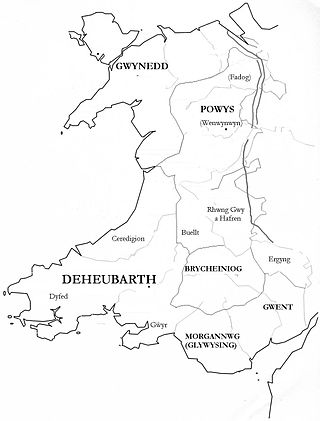Related Research Articles
Caradog ap Gruffydd was a Prince of Gwent in south-east Wales in the time of Gruffydd ap Llywelyn and the Norman conquest, who reunified his family's inheritance of Morgannwg and made repeated attempts to reunite southern Wales by claiming the inheritance of the Kingdom of Deheubarth.
Athrwys ap Meurig was a prince, and possibly king, of Gwent and Glywysing in Wales. He was the son of King Meurig ap Tewdrig and the father of the later king Morgan ab Athrwys. It is possible he died before his father Meurig and did not live to rule as king himself.

Gwent was a medieval Welsh kingdom, lying between the Rivers Wye and Usk. It existed from the end of Roman rule in Britain in about the 5th century until the Norman invasion of Wales in the 11th century. Along with its neighbour Glywyssing, it seems to have had a great deal of cultural continuity with the earlier Silures, keeping their own courts and diocese separate from the rest of Wales until their conquest by Gruffydd ap Llywelyn. Although it recovered its independence after his death in 1063, Gwent was the first of the Welsh kingdoms to be overrun following the Norman conquest.

Glywysing was, from the sub-Roman period to the Early Middle Ages, a petty kingdom in south-east Wales. Its people were descended from the Iron Age tribe of the Silures, and frequently in union with Gwent, merging to form Morgannwg.
Morgannwg was a medieval Welsh kingdom formed via the merger of the kingdoms of Glywysing and Gwent.
Penychen was a possible minor kingdom of early medieval Wales and later a cantref of the Kingdom of Morgannwg. Penychen was one of three cantrefi that made up the kingdom of Glywysing, lying between the rivers Taff and Thaw, the other two being Gwynllwg and Gorfynydd. According to tradition, these cantrefi were created on the death of Glywys, the first king of Glywysing, when the kingdom was divided between his three sons: Pawl, Gwynllyw and Mechwyn. But our knowledge of the early history of the kingdom is very uncertain, being mainly sourced from medieval documents and traditional pedigrees.
Morgan ap Athrwys or Morgan Mwynfawr was a king of Gwent and Glywysing in southeast Wales. He was the grandson of Meurig ap Tewdrig and the son of Athrwys ap Meurig.
Ffernfael ab Idwal or Ithel was a late 8th-century king of Gwent in southeast Wales.
Einion ab Owain was a medieval Welsh prince of the House of Dinefwr. He was the eldest son and probable edling of King Owain of Dyfed, son of Hywel Dda.
Owain ap Hywel was a king of Glywysing and Gwent in southeastern Wales.
Cadwgan ab Owain was a joint king of Glywysing in Wales of the High Middle Ages along with his brother Gruffydd. His other brother Morgan ruled in Gwent.
Gruffydd ab Owain was a joint king of Glywysing in Wales along with his brother Cadwgan. His other brother Morgan ruled in Gwent.
Meurig ab Ithel or Idwal was an 8th-century king of part of Glywysing in southern Wales.
Meurig ap Hywel was a 9th-century prince of Gwent in southeastern Wales.
Hywel ap Rhys was a king of Glywysing in South Wales.
Ithel or Idwal ap Hywel was a king of Gwent in southeastern medieval Wales. He was called king of Gwent and Morgannwg by the Chronicle of the Princes.
Morgan Hen ab Owain or Morgan the Old, first known as Morgan ab Owain of Gwent and also known as Moragn Hen Fawr, was the king of Morgannwg. He ruled from AD 942 to 974.

St Cenedlon's is a parish church in the village of Rockfield, Monmouthshire, Wales. The dedication to St Cenedlon is unusual and the history of the saint is obscure. Some sources suggest that she was a daughter of Brychan king of Brycheiniog while others identify her as the wife of King Arthfael ab Ithel, king of Glywysing. The existing church dates from the Middle Ages but only the tower remains from that period. After the English Reformation, the surrounding area of north Monmouthshire became a refuge for Catholics and Matthew Pritchard (1669-1750), Roman Catholic bishop and Vicar Apostolic of the Western District is buried at the church. By the mid-19th century the church was in ruins and a complete reconstruction was undertaken by the ecclesiastical architects John Pollard Seddon and John Prichard in around 1860. St Cenedlon's is an active parish church in the Diocese of Monmouth. It is designated by Cadw as a Grade II listed building.
Arthfael Hen ap Rhys, also called Arthfael the Old, was the king of the Kingdom of Glywysing between 785 and approximately 825 AD.